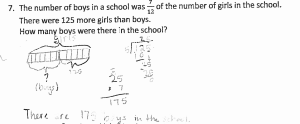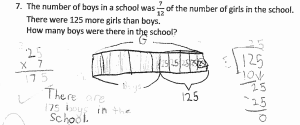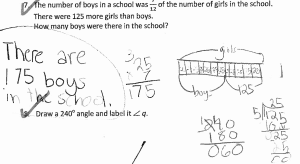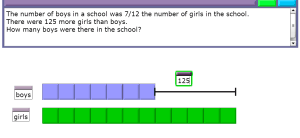After the post on Assessing Bar Model Solutions went up, Beth Curran sent a message: “We just did that problem!” She agreed to share some student work:

And when the students didn’t draw a model:
I see this as a comparison problem:
5 units -> 125 students
1 unit -> 125 ÷ 5 = 25
7 units for boys -> 7 x 25 = 175 boys in all
(That’s the Thinking Blocks Model Drawing tool that allows you to insert your own word problems and solve – or you can use the pre-made questions!)














Students who know the answer without using a model drawing are reluctant to be “co-erced” into doing so, whatever the the future incentive. i offer two suggestions to ensure their familiarity with the models:
Provide a model drawing similar to the one you are expecting others to draw, and ask the student to provide a word problem which accords with the info provided in the model.This approach provides a challenge and ensures that the student is familiar with the model drawing idea which he will benefit from using on more complex problems.
The second idea is to ask students “:What other questions can you ask about the info supplied in this model?” And I am sure there must be others.
Offering a future benefit is the same as saying to a child : If you not eat candies now you will have great teeth when you’re an adult. Logically it works but……
I think that if a child is able to show reasoning through his computation , he should score all the allocated marks if the right answer is given.
I hope these comments are of some value.
Cassy, I enjoy your blog and the passion you demonstrate for Singapore Math.
Jack Garb
Johannesburg
South Africa
Greetings Jack! You’re right, of course, no one wants to coerce students into using the model. More difficult problems get many students excited, but not all. The strategy of using a model and having students write the word problem is one I’ve used often. It is certainly engaging. The important thing that teachers need to keep in mind is that the whole point of model drawing is to help students see the computation, so they don’t need the models! I do like how encouraging students to use models encourages them to show their thinking. This is very valuable when you have a student struggling as it allows me to see their thought process more clearly.
As always, the rubric for assessing word problems should be used with discretion. I once had a teacher tell me that if the students didn’t capitalize their final sentence or use a period, they’d lose a point. That’s too strict an interpretation to me.